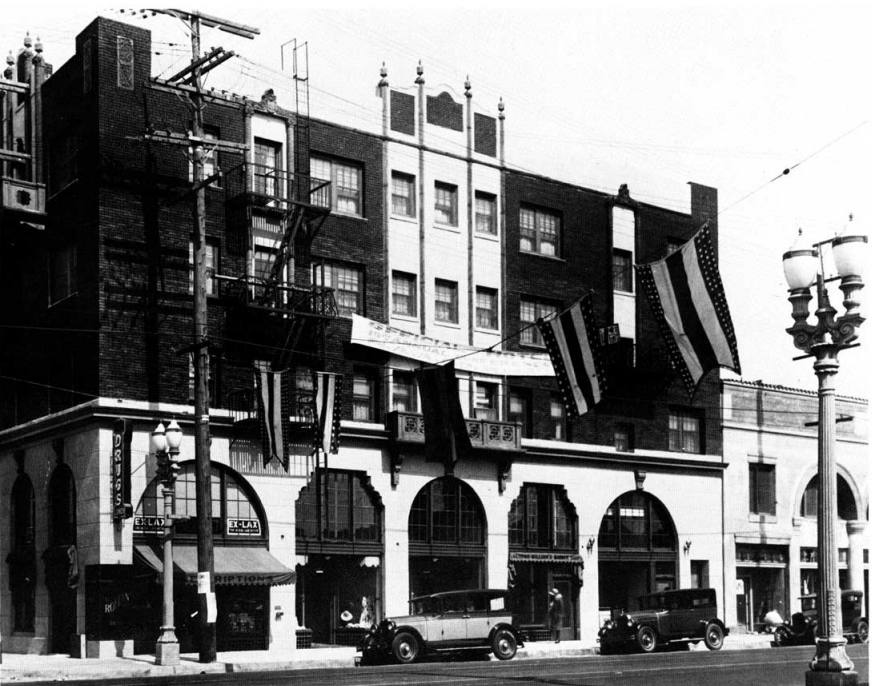Dunbar Hotel
4225 S. Central Ave.
Green Book Editions: 1939-1941, 1947-1957, 1959-1961
Manager: George Hart
Bertrand B. Bratton, Prop
James Nelson, Owner
Julia Nelson, Manager
Built: 1928
Status: Still in operation
Dr. John Alexander Somerville
Dunbar Courtyard Entry - 2016
DUNBAR HOTEL
After being repeatedly being denied rooms in white hotels, a prominent black dentist, Dr. John Alexander Somerville built the Dunbar (named The Somerville at the time) in 1928. It’s reportedly the first American hotel built expressly for black people and for years it was one of the only major hotels in Los Angeles that served blacks. It was so special, people called it the Waldorf-Astoria of black America.
Hotel Groundbreaking
It wasn’t long before the Dunbar became the social and cultural hub for the black intelligentsia. The brick and brownstone landmark has four-floors and 115 rooms. During its illustrious reign, the Dunbar served legendary talents such actor Paul Robeson, W.E.B. DuBois, Cab Calloway, Red Foxx, Billie Holiday and Duke Ellington. Count Basie, Louis Armstrong and Ella Fitzgerald played next door at Club Alabam (also a Green Book business). Mayor Tom Bradley said, “I remember from the days of my childhood, walking down the avenue just to get a look at some of those famous superstars who stayed at the Dunbar.”
The Somerville Hotel in 1928
In 1930, ownership of the hotel passed to Lucius Lomax and he renamed it the Dunbar after the turn-of-the-century African American poet Paul Laurence Dunbar. In 1936, a black Chicago businessman, James Nelson, bought the hotel. He passed away in 1952 at the age of 70.
In the Los Angeles Sentinel, Celes King III who was a bail bondsman to the civil rights movement, the former president of the LA Branch NAACP, and the state chairman of the Congress of Racial Equality (CORE) said, “In 1936, my dad’s uncle, Jimmy Nelson purchased the Dunbar for $87,500 in cash and then asked my dad to come out to LA to manage the hotel for him. King remembers that “civil rights issues were discussed openly every night at the Dunbar. And I listened to the elders – men like Sentinel publisher Leon Washington, journalists Lawrence Lamar and attorney Loren Miller —who were among the men who came into the hotel every night.”
The Dunbar Lobby - 2015
The Dunbar was listed in the Green Book for 14 years along with the adjoining beauty parlor and liquor store. In 1952, a Dunbar advertisement boasted, “Excellent accommodations and efficient service. There’s a phone for every room, running water.” Daily Rates: Plain - $2; $2.25 - private shower; $2.50 – private bath
In 1974 the building was shuttered because it didn’t meet the required fire codes and by 1987 the Dunbar deteriorated into a graffiti-scarred ruin. Since then, the Community Development Department and Community Redevelopment Agency spent $2.9 million renovating the hotel and provided 72 low-income housing units.
The Dunbar Hotel Cultural and Historical Museum was declared a cultural monument on November 3, 1974. Bernard Johnson, founder and director of the Dunbar Hotel Cultural Historical Museum and co-chairpersons on the board’s historical committee, Mrs. Enola Ewing and Charles Haywood helped to honor and preserve this historic treasure. Thanks to their efforts and others, the property is listed on the National Historic Register. Today the Dunbar operates as a senior center.
Dunbar Exterior - 2016






